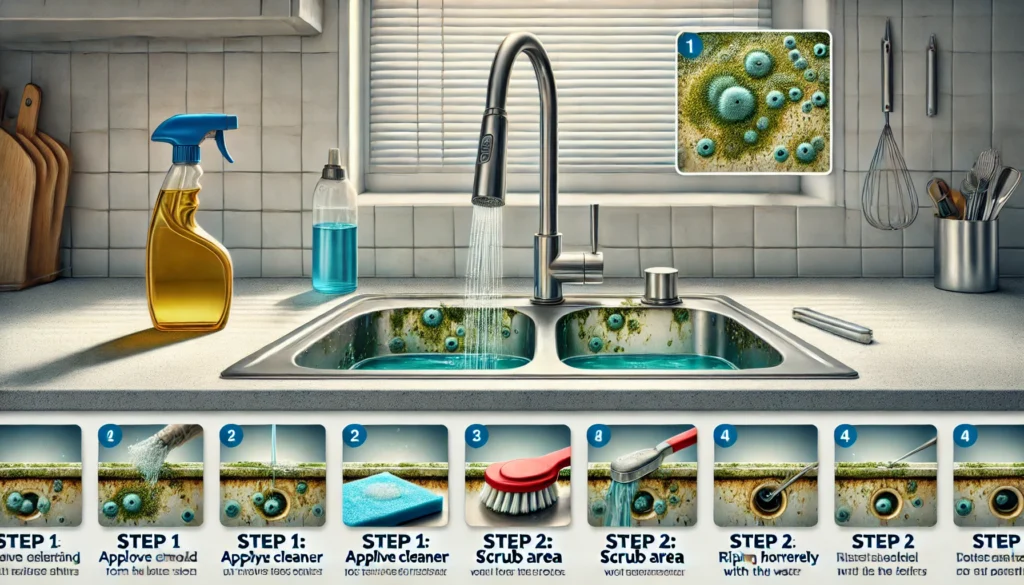How to Remove Mold Sling from Kitchen Sink
Have you ever noticed a slimy, slippery substance hanging around your kitchen sink? It’s a sign that mold has built up, and not only is it unsightly, it can be a health hazard. Mold slime thrives in moist environments, especially in areas like kitchen sinks where water and food particles accumulate. But don’t worry! With a little effort and the right approach, you can tackle this problem head-on.
Why Mold Slime Forms in Kitchen Sinks
Mold is an unwelcome guest in any home, and one of the most common places it can appear is under the kitchen sink. When you discover black mold under the sink, it’s critical to address the problem immediately and effectively.
In this comprehensive guide, we’ll explore how to remove black mold under the sink, prevent its reappearance, and ensure a healthy living environment. We’ll also discuss related topics such as mold spores, protective equipment, and mold removal.
What Is Mold Slime?
Mold slime is a combination of mold, fungus, bacteria, and organic material. It usually appears as a dark, slippery film around the sink or drain. Constant moisture and food debris create the perfect environment for this nasty slime to form.
Why Is Mold Slime Harmful?
Mold is not only unsightly, but it can also be harmful. Exposure to mold can lead to respiratory problems, skin irritation, and allergies. Plus, if left untreated, it can damage your sink, pipes, and even spread to other parts of your kitchen.
List of Cleaning Tools and Supplies
Before you start cleaning, make sure everything is in order. Wear gloves to protect your skin, a mask to avoid inhaling mold spores, and open a window or turn on a fan to ventilate the area.
Here’s what you’ll need:
- Rubber gloves
- A mask
- A scrubbing brush or sponge
- Baking soda
- Vinegar or a mold-specific cleaner
- Hot water
- A microfiber cloth
Step-by-Step Cleaning Guide

Step 1: Prepare the Area
Make sure the affected area is well ventilated. Open all the windows and doors in your home to allow fresh air in and circulate. This will help dissipate mold spores and reduce your exposure.
Step 2: Protect Yourself
Put on protective gear, including rubber gloves, a mask, and goggles, to prevent direct contact with mold and inhalation of mold spores.
Step 4: Mix a Cleaning Solution
Create a cleaning solution by mixing warm water with baking soda. Baking soda is a natural and effective mold cleaner. Combine one part baking soda with two parts warm water to form a paste.
Step 5: Apply the Cleaning Solution
Use a sponge or cloth to apply the baking soda paste to the mold-infested areas under the sink. Scrub gently, making sure to cover all affected surfaces. The baking soda will help break down and remove the mold.
Step 6: Rinse and Dry
After scrubbing, use warm water to rinse the area and remove any remaining residue. Make sure the area is completely dry, as moisture is the main factor that allows mold to thrive.
How to Prevent Mold from Appearing in the Future
Once you have successfully removed mold, it is essential to take preventative measures to prevent it from appearing again. Here are some tips to help you maintain a mold-free environment:
Fix leaks – Fix any plumbing issues immediately to prevent water buildup in the future.
Improve ventilation – Ensure proper airflow by using exhaust fans, opening windows, or using a dehumidifier if necessary.
Regular cleaning – Regularly clean and inspect the area under your kitchen sink to detect any mold growth early.
Seal grout and caulk – If your sink is sealed with grout or caulk, make sure it is well maintained and reseal it if necessary.
Use Mold-Resistant Paint – Consider using mold-resistant paint in your kitchen to inhibit mold growth on walls and ceilings.
Know When to Call a Professional
In some cases, mold problems can be extensive and difficult to handle on your own. If you have a serious mold problem or are dealing with black mold under the sink or other black mold issues, it is advisable to consult a professional mold remediation service. These experts have the equipment and experience to safely and effectively remove mold from your home, ensuring that it does not reoccur.
Removing mold grime from your kitchen sink requires a combination of proper cleaning techniques and preventative measures. By following these steps, you will be able to effectively remove mold grime and maintain a clean and healthy kitchen environment.
Related Articles:
How to Remove Mold Under Vinyl Flooring
Is Mold Remediation Covered by Home Insurance
Mold Removal, Remediation & Inspection Services Near You [Free Quotes]
